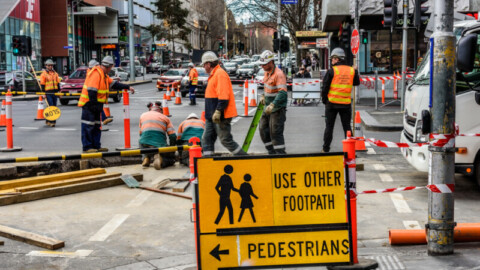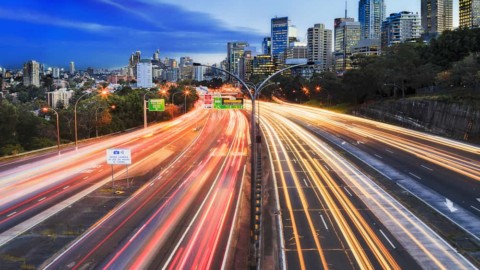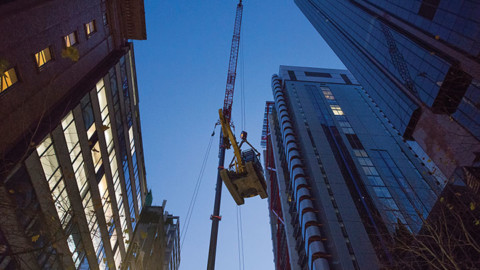ABB has harnessed the latest technology to give Melbourne passengers a smoother, lower-carbon ride.
The company’s system gathers the energy from a braking train as it approaches a station, briefly stores it, then reinjects it into the train’s power supply as it accelerates on its way.
The energy redistributor has been applied as an alternative to building and connecting a new rectifier substation Metro Trains Melbourne (Metro) Hurstbridge Line Upgrade Project.
The Australian-first application of ABB’s 1,500V DC ABB Enviline Energy Storage System (ESS), which stores and returns the surplus braking energy back to the grid, will allow the Metro service to make more efficient use of electricity, increasing its sustainability and allowing it to add extra trains at a lower-than-usual cost.
The pilot project, completed in late 2021, has had to negotiate several obstacles on its three-year journey to completion.
Two ABB engineers, Stephen Poh, Product Marketing Manager of AC and DC Traction Power, and Steven Dineen, Lead Project Engineer, together with the ABB factory team in Bielsko-Biala, Poland, have continuously aligned and realigned tracks with the customer to complete this project.
When Metro first tendered the project on the Hurstbridge Line in 2017, ABB had already been engaged in working out what kind of solution would best be applied to the gap in energy supply around Diamond Creek, between Wattle Glen and Eltham on the Hurstbridge Line.
Pre-pandemic, Diamond Creek Tie Station had experienced frequent voltage drops, withMetro seeking a solution to provide customers a smoother journey. Metro also wanted to increase the frequency of trains on the line, which would increase the requirement for more reliable energy at Diamond Creek.
A piece of string can’t be too long
“Imagine electricity supply is like a piece of string,” Mr Poh said.
“The longer the distance between substations, the looser that string gets until there’s a real dip in between. The traditional solution is to put in another rectifier substation, to improve that supply dip. Metro identified a business case to work with us on an energy management solution.”
ABB understood that an energy management system would be more cost effective in terms of land use and construction.
Add to that a 15 per cent reduction in carbon emissions, achieved by effectively recycling otherwise lost energy in the grid, and the ability to supplement electricity drawn from the grid, and the energy management system was decided as the best option for Diamond Creek.
ABB was awarded the project based on its strong local presence in Australia, which would enable easy collaboration, and because of its experience with this technology.
ABB had previously developed ESS solutions for 750V rail lines in the United States and Europe, but in the southern states of Australia, mainly Victoria and New South Wales, rail lines run on 1,500V.
“For this high-capacity, high-voltage environment we needed to engineer a 1,500V version,” Mr Poh said.
ABB’s ESS subject matter experts were based in the Polish Technology Centre and worked for 12 months with the engineering team in Australia, developing and testing a 1,500V DC energy storage system using supercapacitor storage with 44MJ capacity, which met Metro requirements and applicable standards.
The Australian drive toward super safety
Metro subsequently requested a higher level of safety for its maintenance employees.
“When you’re working on this equipment, you need to make sure everything is turned off, so you know it’s safe to go in and work on it,” Mr Dineen said.
Internationally, such earthing systems have been manually operated, but for Metro this posed a high risk.
“Metro requested that we incorporate automatic earthing switches into the design of the ESS, so that the equipment earths itself at the flick of a switch,” Mr Dineen said.
ABB took Metro’s feedback on board and redesigned the energy storage system.
“We created a 20-page specification just for the innovative automatic earthing piece,” Mr Poh said.
ABB procured unique parts and engineered a new system, integrating the highest level of safety to meet Metro needs. The equipment then had to go back into the manufacturing phase and into its own testing phase.
With the COVID-19 pandemic came the challenge of installation and testing on-site that would normally involve ABB’s Polish team together with local ABB experts. Instead, ABB initiated a virtual commissioning process to allow all parties, including Metro and overseas colleagues, to remotely conduct the operation.
“The process of organising a midnight-to-dawn tuning run with rolling stock, train drivers, controllers and so on had begun, when countries started shutting their borders in response to the COVID-19 pandemic. Our Polish team had young families and couldn’t be stuck in Australia indefinitely,” Mr Dineen said.
“So they rushed back home, and we began working out how we could commission the system with them remotely supporting the necessary procedures.”
In the first half of 2021, the system was commissioned, and in late 2021 the ESS was connected to the Hurstbridge Line’s network.
“Not a moment of the three years plus of assessment and engineering has been in vain. Both the original Enviline 1,500V global-standard ESS and the unique ultra-safety-enhanced system are now fully tested to meet Metro requirements,” Mr Poh said.
On track to maximise returns
You might imagine that every urban transport and railway operator in the world would like a slice of this energy-recycling, sustainable technology. Poh and Dineen have pointed out that several factors will maximise the returns on investment of a substation substitute.
For example, it generates the most energy at stations where the train must substantially apply its brakes as it approaches the platform, so flat or curvy approaches will limit the energy generated. The Enviline ESS can capture up to 30 per cent of otherwise wasted energy which can represent a significant saving on electricity otherwise drawn from the grid.
“And of course, if your line or network has the right conditions for ten of these, you get ten times the benefits,” Mr Poh said.
Metro will continue to study its network demand to identify more business cases for the use of the Energy Management System, and the static energy storage system Enviline ESS will continue to evolve in response to customer needs.
“Metro may decide it would love the system even more if it had expanded storage, so that the energy captured could be directed to power multiple needs,” Mr Poh said.
“ABB always strives first for the best, and then to get more out of its engineering.”
The ABB team have stated their eagerness to continue this journey. However, for the moment, they are basking on the platform of a three-year project well-delivered, with now tried and tested technologies that can help railways around the globe run more lightly across the earth’s surface.
This sponsored editorial is brought to you by ABB. For more information, visit https://new.abb.com/au.

















